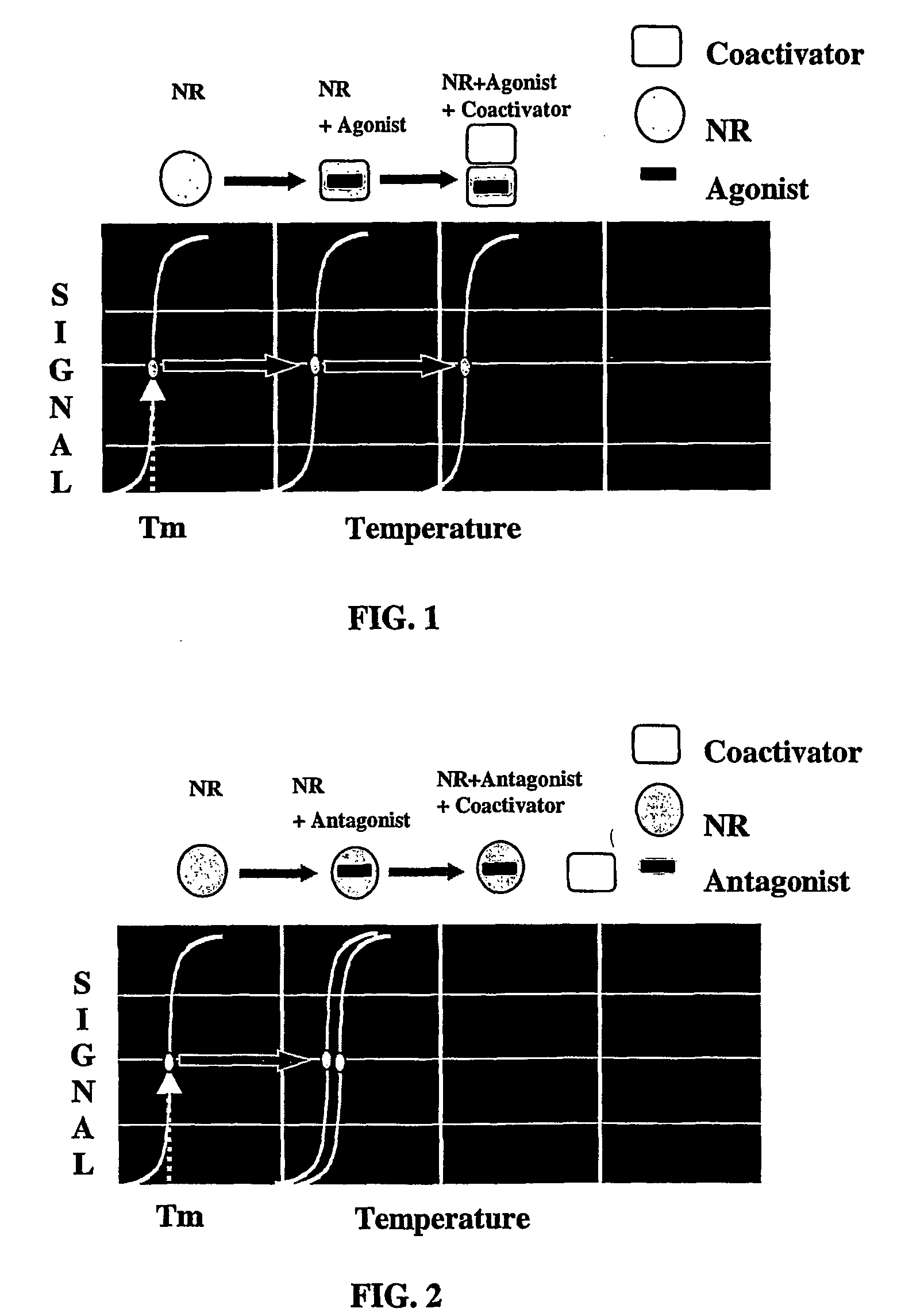Method for the idenification of ligands
- Summary
- Abstract
- Description
- Claims
- Application Information
AI Technical Summary
Benefits of technology
Problems solved by technology
Method used
Image
Examples
example 1
[0115] Table 1 is a summary of the data obtained for ER-c and ER-β for the study of a panel of four known agonist and three known antagonists in the presence of a co-activator protein SRC-3; in the presence of two co-activator peptides SRC1—NR2 and SRC3—NR2 derived from the sequence of the co-activators SRC-1 and SRC-3; and in the presence of the co-repressor peptide NCoR-1 derived from the co-repressor NCoR-1.
[0116] The concentration of ER-α and ER-β in all of the experiments was 8 μM, the ligand concentration was 20 μM, SRC-3 was 11 μM, and the co-regulator peptides SRC1—NR2, SRC3—NR2, and NCoR-1 was at 100 XM. The experiments were performed in 25 mM phosphate pH 8.0, 200 mM NaCl, 10% glycerol and in the presence of 25 μM dapoxyl sulfonamide dye (available from Molecular Probes, Inc., Eugene, Oreg.).
[0117] A 2 μL ligand solution at 2 times the final concentration was dispensed with a micropipette into a 384 well black wall Greiner plate. Then, 2 μL of the protein dye solution wa...
example 2
[0121] ER-α was screened against a panel of steroid-like ligands to verify the ability of the methods of the present invention to determine ligands, and the function (see U.S. Patent Publication No. U.S. 2001 / 0003648 A1), of ER-(X if this receptor was classified as an orphan. Ligands that are known to interact with ER-α are identified as producing an increase in the stability of the receptor (compounds that are underlined versus those which are not underlined).
[0122] The concentration of ER-α in all of the experiments was 8 μM and the ligand concentration was 20 μM. The experiments were performed in 25 mM phosphate pH 8.0, 200 nM NaCl, 10% glycerol and in the presence of 25 μM dapoxyl sulfonamide dye (available from Molecular Probes, Inc., Eugene, Oreg.).
[0123] A 2 μL ligand solution at 2 times the final concentration was dispensed with a micropipette into a 384 well black wall Greiner plate. Then, 2 μL of the protein dye solution was dispensed on top of the ligand solution in the...
example 3
[0125] Examples of other protein-protein interactions that may be analyzed using the present invention are illustrated in Table 2.
TABLE 2Embodiment examplesProteinProtein ofPartner (co-LigandInterestregulator)PhenotypeRelated Biological ActivityGPCRGsαAgonistIncrease cAMP or stimulateregulation of Ca2+ channelsGPCRGiαAgonistDecrease cAMPGPCRGoαAgonistStimulate regulation of Ca2+channelsGPCRGtαAgonistIncrease cGMP andphosphodiesterase activityGPCRGqαAgonistIncrease phospholipase CβactivityGPCRGsαAntagonistNo effect on basal activity, ordecrease cAMP, or inhibition ofCa2+ channel stimulationGPCRGiαAntagonistNo effect on basal activity, orincrease cAMPGPCRGoαAntagonistNo effect on basal activity, orinhibition of Ca2+ channelstimulationGPCRGtαAntagonistNo effect on basal activity, ordecrease cGMP andphosphodiesterase activityGPCRGqαAntagonistNo effect on basal activity, ordecrease phospholipase CβactivitySrcSH2AntagonistInhibition of osteoclast mediatedresorption of boneSrcSH2AgonistS...
PUM
 Login to View More
Login to View More Abstract
Description
Claims
Application Information
 Login to View More
Login to View More - R&D
- Intellectual Property
- Life Sciences
- Materials
- Tech Scout
- Unparalleled Data Quality
- Higher Quality Content
- 60% Fewer Hallucinations
Browse by: Latest US Patents, China's latest patents, Technical Efficacy Thesaurus, Application Domain, Technology Topic, Popular Technical Reports.
© 2025 PatSnap. All rights reserved.Legal|Privacy policy|Modern Slavery Act Transparency Statement|Sitemap|About US| Contact US: help@patsnap.com

